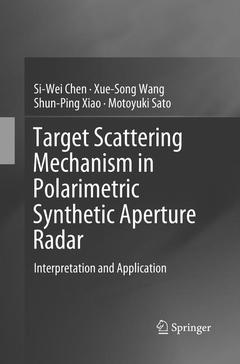Description
Target Scattering Mechanism in Polarimetric Synthetic Aperture Radar, Softcover reprint of the original 1st ed. 2018
Interpretation and Application
Authors: Chen Si-Wei, Wang Xue-Song, Xiao Shun-Ping, Sato Motoyuki
Language: English
Subjects for Target Scattering Mechanism in Polarimetric Synthetic...:
105.49 €
In Print (Delivery period: 15 days).
Add to cartPublication date: 02-2019
Support: Print on demand
105.49 €
In Print (Delivery period: 15 days).
Add to cartPublication date: 05-2018
Support: Print on demand
Description
/li>Contents
/li>Biography
/li>Comment
/li>
This book presents new and advanced concepts, theories and methodologies in polarimetric synthetic aperture radar (PolSAR) target scattering mechanism modeling and interpretation, which is dedicated to bridge the gap between the acquired data and practical applications. It proposes adaptive and generalized polarimetric target decompositions, to precisely interpret the target scattering mechanisms. Further, it develops a uniform polarimetric matrix rotation theory and a polarimetric coherence pattern visualization and interpretation tool to completely explore and characterize the deep information and target signatures in the rotation domain. Finally, it demonstrates land cover classification, target detection, natural disaster damage investigation and mapping applications which use the novel scattering mechanism investigation tools.
The book is a valuable resource for senior undergraduate and postgraduate students, teachers, engineers and researchers in the field of microwave remote sensing, radar polarimetry, imaging radar, and environmental studies.
Si-Wei Chen is an Assistant Professor of the State Key Laboratory of Complex Electromagnetic Environment Effects on Electronics and Information System, School of Electronic Science, National University of Defense Technology, Changsha, China. His research interests include radar polarimetry, synthetic aperture radar, environmental study, natural disaster evaluation, remote sensing big data and deep learning. He has published more than 50 international top journal and conference papers, including Proceedings of the IEEE, IEEE Signal Processing Magazine, IEEE Transactions on Geoscience and Remote Sensing,etc. He has given more than 10 invited presentations at international conferences and top academic institutes. He has co-authored 2 patents and more than 10 patents under pending. Dr. Chen was a recipient of the Young Researcher Award from the IEEE GRSS—Japan Chapter in 2011, the Dean Prize from the Graduate School of Environmental Studies, Tohoku University, in 2013, the Best Poster Award from the IET International Radar Conference 2013, the Excellent Paper Award from the IET International Radar Conference 2015, the Excellent Paper Award from the High Resolution Earth Observation Annual Symposium 2017. He was also a receipt of the First Prize and Second Prize for Scientific and Technological Progress, Ministry of Science and Technology of the People’s Republic of China. He was granted with Tohoku University President Fellowship (2011–2012) and Chinese Government Overseas Study Scholarship (2009–2012). Dr. Chen is a Principle Investigator of 3 foundations from the National Natural Science Foundation of China.
Xue-Song Wang is a Professor of the State Key Laboratory of Complex Electromagnetic Environment Effects on Electronics and Information System, School of Electronic Science and a Vice-Dean of the Graduate School, National University of Defense Technology, Changsha, China. His research interests include radar polarimetry, synth
These books may interest you

Polarimetric Microwave Imaging 179.34 €

Weather Radar Polarimetry 64.97 €


